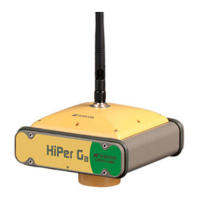HiPer Ga/Gb Receiver Setup and Survey
HiPer Ga/Gb Operator’s Manual
4-10
hours. The optimal observation session length depends on the
surveyor’s experience as well as the following factors:
• The length of the baseline measured
• The number of satellites in view
• The satellite geometry (DOP)
• The antenna’s location
• The ionospheric activity level
• The types of receivers used
• The accuracy requirements
• The necessity of resolving carrier phase ambiguities
Generally, single-frequency receivers are used for baselines whose
lengths do not exceed 15 kilometers (9.32 miles). For baselines of 15
kilometers or greater, use dual-frequency receivers.
Dual-frequency receivers have two major benefits. First, dual-
frequency receivers can estimate and remove almost all ionospheric
effect from the code and carrier phase measurements, providing much
greater accuracy than single-frequency receivers over long baselines
or during ionospheric storms. Secondly, dual-frequency receivers
need less observation time to reach the required accuracy.
After the survey completes, data the receivers collect can be
downloaded onto a computer and processed using post-processing
software (for example, Topcon Tools).

